In the vast tapestry of Norse mythology, Gunnlöd stands as a captivating figure, a jötun (giantess) whose tales intertwine with the gods. Her story, though not as widely recognized as some, offers a unique perspective on the relationship between the Aesir and the Jotnar (giants).
Gunnlöd Key Facts
| Parents | Suttung and unnamed mother |
| Partners | Odin |
| Siblings | Unknown |
| Offspring | Bragi |
| Tribe | Jötun |
| Old Norse name | Gunnlöð |
| Other names | None known |
Name and Etymology
Gunnlöd’s name in Old Norse is a fascinating blend of two distinct elements: *gunnr and *lǫð. The term *gunnr translates to “battle” or “warfare,” reflecting the tumultuous nature of the Norse cosmos and the constant struggles between the gods, giants, and other beings. This prefix paints a picture of a figure deeply intertwined with conflict, perhaps not just in a physical sense but also in the realms of emotion and strategy.
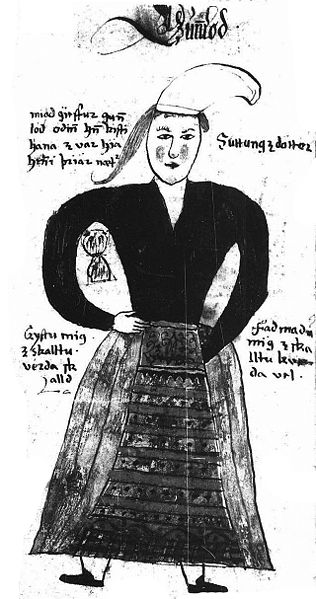
On the other hand, *lǫð carries the meaning of “invitation” or “offer.” This part of her name introduces a softer, more inviting aspect to her character. It suggests a duality where, amidst the chaos of battle, there exists an offer or an opportunity. When combined, Gunnlöd’s name can be interpreted as an “invitation to battle” or a “battle offer,” hinting at her role as both a guardian of the coveted mead of poetry and a lover to Odin.
Kennings for Gunnlöd
While there aren’t direct kennings for Gunnlöd, her name intriguingly appears in kennings for both Frigga and Jord. In these kennings, Gunnlöd is referred to as a “co-wife,” which provides a deeper insight into her significance in the Norse pantheon. This particular mention strengthens the belief that Gunnlöd was more than just a fleeting encounter for Odin. Her being named as a “co-wife” alongside prominent figures like Frigga and Jord suggests a deeper, more established relationship. This further solidifies the view that she was indeed the mother of Bragi, emphasizing her role not just as a guardian of the mead but also as a pivotal figure in the lineage of the gods.
Ancient roots
While Gunnlöd’s presence is firmly rooted in Norse mythology, traces of her essence can be found in older Germanic traditions. However, direct parallels in Gothic or Roman mythologies are sparse. It’s fascinating to think that her story might have evolved from ancient tales, adapting and changing with each retelling.
Gunnlöd Origins
Gunnlöd’s lineage is deeply rooted in the intricate web of relationships and vendettas that characterize Norse mythology. She is the daughter of Suttungr, a formidable jötunn with a tragic past. Suttungr, was the son of Gilling. Gilling, along with Suttungr’s mother, met a tragic end at the hands of the cunning dwarves Fjalar and Galar. This act of treachery set off a chain of events that would eventually lead to Gunnlöd’s guardianship of the mead of poetry.
The murder of Suttungr’s parents by the dwarves adds layers of complexity to Gunnlöd’s story. It provides context to the power dynamics and the constant tussle for supremacy among the various beings in the Norse cosmos. Her birth, amidst such turmoil and revenge, positions her as a figure of significance, not just among the jötnar but also in the overarching narrative of Norse myths.
Gunnlöd Family and Relationships
Gunnlöd’s relationships weave a tale of intrigue, power dynamics, and the delicate balance between trust and strategy that permeates Norse mythology.
Odin
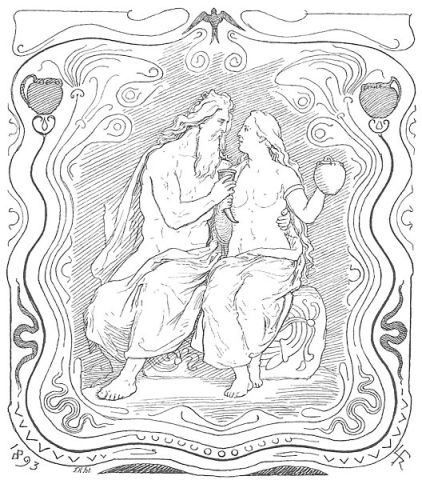
Among her relationships, the one with Odin, the Allfather of the gods, stands out prominently. Their connection was not just a fleeting romance but a calculated alliance. Odin, with his sights set on a certain treasure Gunnlöd guarded, approached her with a seemingly simple agreement: he would spend three nights with her, and in return, he’d be granted three sips of the mead. Gunnlöd, perhaps charmed by the god or sensing an opportunity, consented.
However, as with many of Odin’s dealings, things didn’t unfold as straightforwardly as they seemed. The aftermath of their encounter would have repercussions that echoed throughout the realms, but the details of that tale are best saved for another chapter.
Children
From her union with Odin, Gunnlöd became the mother of Bragi. Bragi, infused with the spirit of the mead, rose to prominence as the god of poetry and eloquence. His stories, filled with lyrical prowess, serve as a testament to the legacy of his parents and the circumstances that brought him into the world.
Play Jötunn Quiz
Do you want to learn more about the magical and powerful Jötunn? Then test your knowledge with this fun quiz game!
Don’t forget to play our other games as well!
Gunnlöd Role And Depiction
Gunnlöd’s role in Norse mythology is multifaceted, embodying both strength and vulnerability, guardianship and desire.
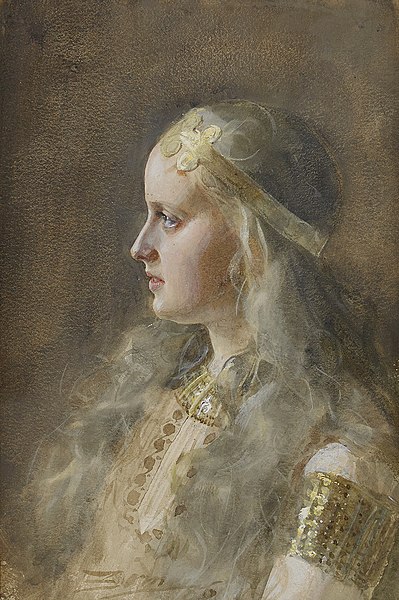
As the guardian of the mead of poetry, she held a position of immense importance. This wasn’t just any treasure; it was an elixir that could bestow the gift of eloquence and poetic prowess upon its drinker. Her guardianship wasn’t a mere duty; it was a testament to her strength and significance among the jötnar. The mead’s location, deep within the mountain Hnitbiorg, further emphasizes its value. Locked away in a cave, it was shielded from the world, and Gunnlöd, its fierce protector, was its gatekeeper.
Yet, her depiction isn’t solely that of a guardian. In the poem Hávamál, Odin himself speaks of Gunnlöd as “a fine woman.” This description paints a picture of a jötun of beauty and allure. The verses hint at a deep connection between them, a blend of passion and strategy. “Gunnlöd gave me, on the golden throne, a drink of the dear-won mead,” Odin recounts, highlighting the sacrifice and the gift she offered. But the lines that follow, “In return I gave her bad recompense, for her whole heart, for her sorrowful soul,” reveal the depth of their entanglement and the heartache that ensued.
Odin’s confession, “I doubt I would have returned back from the giants’ domain, if I hadn’t had Gunnlöd, that fine woman whom I laid in my arms,” further underscores her allure and significance in his quest. It paints a portrait of Gunnlöd as both a formidable guardian and a captivating figure of desire, a duality that adds layers to her character in the vast narrative of Norse mythology.
Gunnlöd Artifacts
The most significant artifact associated with Gunnlöd is the mead of poetry. This magical beverage, said to be made from the blood of the wise being Kvasir, was a symbol of artistic inspiration. Its origins are steeped in treachery and cunning, with the dwarves Fjalar and Galar murdering Kvasir and using his blood to brew the mead.
But the mead wasn’t stored in just any vessel, it was kept in a kettle and two vats. The kettle is named Ódrerir, and the vats Són and Bodn. These containers weren’t mere storage vessels; they were integral to the mead’s lore, safeguarding it and, by extension, the power it held. Each container’s name carries its own weight and significance, hinting at the layers of stories and myths surrounding the mead.
Gunnlöd’s guardianship of these vessels, and the mead they held, positions her as a central figure in the tales of ambition, strategy, and desire that run through Norse mythology. Her association with such a powerful artifact underscores her importance and the lengths beings would go to obtain a sip of this magical brew.
Myths about Gunnlöd
The tale of the Mead of Poetry is one of the most captivating myths in Norse mythology, and Gunnlöd stands at its heart, both as a guardian and a pivotal character in the unfolding drama.
The story begins with the creation of Kvasir, a being of unparalleled wisdom, born from the combined saliva of the Æsir and the Vanir, two prominent groups of gods. Kvasir’s wisdom was sought after, and he journeyed across realms, imparting knowledge wherever he went. However, his journey was cut short by the treacherous dwarfs, Fjalar and Galar. They killed Kvasir, draining his blood to create a potent brew. By mixing his blood with honey, they crafted the Mead of Poetry, a drink that granted its consumer the gifts of skaldship and profound wisdom.
The malevolence of Fjalar and Galar didn’t end there. They went on to murder a jötunn named Gilling and his wife. In retaliation, their son, Suttungr, confronted the dwarves. Fearing for their lives, the dwarves offered the Mead of Poetry as a peace offering. Suttungr, seeing the value of this magical brew, accepted and decided to hide it from the world. He chose the heart of the mountain Hnitbjorg as its resting place and tasked his daughter, Gunnlöd, with its protection. To ensure its safety, he transformed Gunnlöd into a witch, amplifying her powers to guard the precious mead.
Odin wants the mead for himself
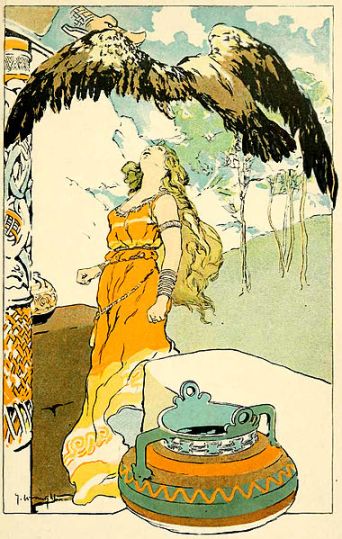
Odin, always in pursuit of knowledge and power, set his sights on this coveted mead. He devised a plan, working under the guise of a laborer for Baugi, Suttungr’s brother. After a summer of toil, Odin requested a sip of the mead, but Suttungr refused. Undeterred, Odin had Baugi drill a hole into Hnitbjorg. Transforming into a snake, Odin slithered through the opening, coming face to face with Gunnlöd.
Odin, using his charm, struck a deal with Gunnlöd: three nights together in exchange for three sips of the mead. However, Odin’s thirst for the mead was insatiable. In those three sips, he drained all the containers, absorbing the mead’s power. Transforming into an eagle, he made his escape, with Suttungr, also in eagle form, hot on his trail. After a tense chase, Odin reached Asgard, ensuring the mead’s safety and sharing it with the gods. As a lasting reminder of his time with Gunnlöd, she bore him a son, Bragi. He would later become the god of poetry and eloquence.
Mentions in Ancient Texts
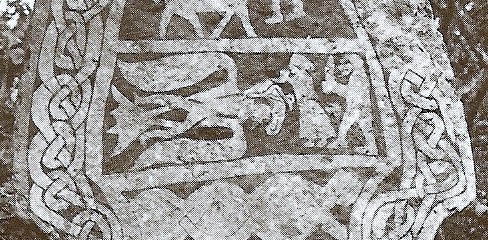
Prose Edda
Skáldskaparmál (The Language of Poetry)
The Skáldskaparmál, part of the Prose Edda, tells of Suttungr entrusting Gunnlöd with the mead of poetry’s protection inside Hnitbiorg. Odin, disguised as a snake, gains access and seduces Gunnlöd. After spending three nights with her, she allows him three sips of the mead. Odin consumes it all and flees as an eagle.
“Bolverk [Odin] went to where Gunnlöd was and lay with her for three nights and then she let him drink three draughts of the mead. In the first draught he drank everything out of Odrerir, and in the second out of Bodn, in the third out of Son, and then he had all the mead. Then he turned himself into the form of an eagle and flew as hard as he could.”
Poetic Edda
Hávamál
The Hávamál, a cornerstone of the Poetic Edda, offers a slightly different account of the events, with a particular emphasis on Gunnlöd herself. Odin’s recounting here diverges in some details, painting a more intimate portrait of his relationship with Gunnlöd. Their bond, though brief, was intense, and the verses reflect both the passion and the subsequent betrayal.
“106. Gunnlod gave me, on her golden seat, a draught of the precious mead; a bad recompense I afterwards made her, for her whole soul, her fervent love.”
On one hand, Odin acknowledges the depth of their connection. Moreover, he also admits that his return from the giants would have been improbable without Gunnlöd’s assistance and affection.
“109. “It is to me doubtful that I could have come from the Jotun’s courts, had not Gunnlod aided me, that good damsel, over whom I laid my arm.”
Frequently Asked Questions
Gunnlöd was the guardian of the mead of poetry, a magical beverage that granted poetic skills.
Bragi, the god of poetry and eloquence, was the son of Gunnlöd and Odin.
Odin spent three nights with her and promised to take only three sips of the mead. However, he drank all of it in those sips and fled.
It’s a symbol of artistic inspiration and was sought after by many, including the gods.
The identities of Gunnlöd’s siblings remain a mystery in Norse mythology.
Featured Image Credit: Johannes Gehrts, Public domain, via Wikimedia Commons
